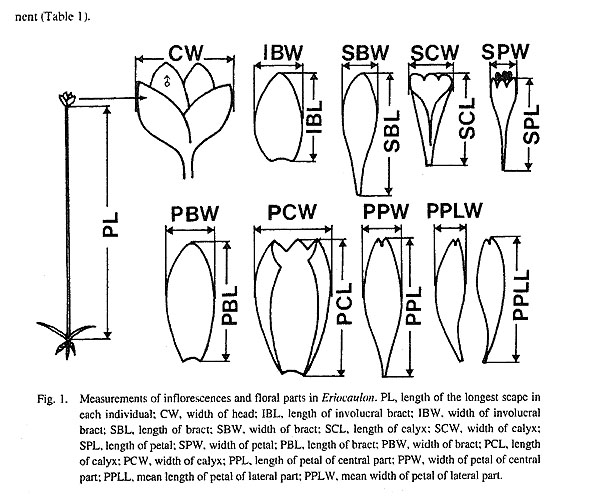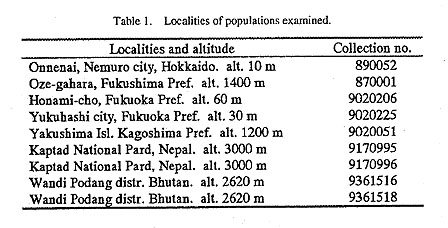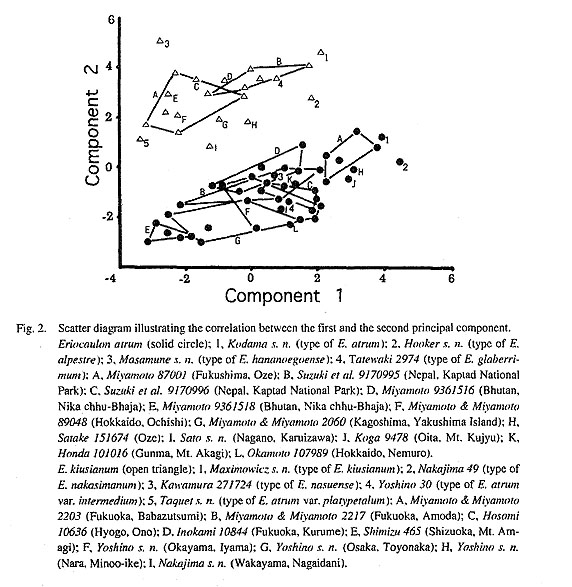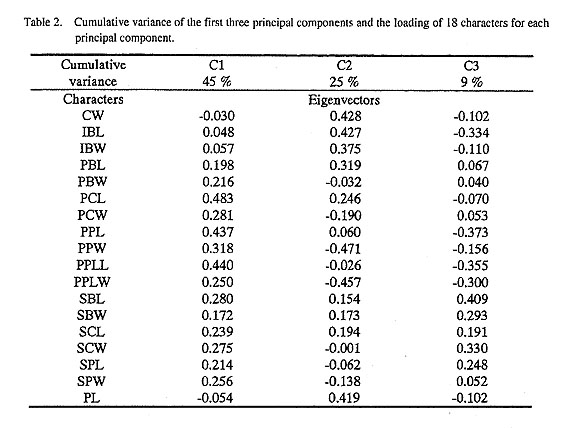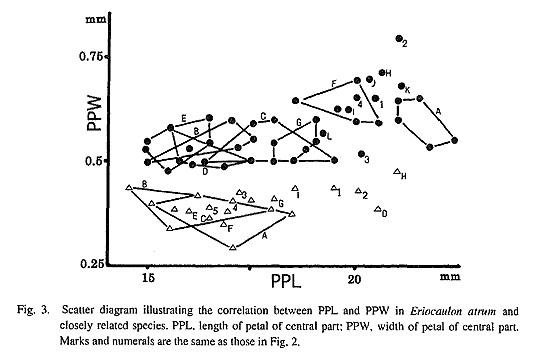Biogeography and Taxonomy of Eriocaulon atrum Nakai and E. kiusianum Maximowicz (Eriocaulaceae)
Futoshi Miyamoto1 and Hideaki Ohba2
1Tokyo University of Agriculture. Sakuragaoka 1-1-1, Setagaya, Tokyo 156, Japan
2University Museum, University of Tokyo, Hongo 7-3-1, Tokyo 113, Japan
|
Abstract. Distribution patterns of Eriocaulon atrum and E. kiusianum (Eriocaulaceae) were studied. Eriocaulon atrum is distributed in the eastern Himalaya, southwest China, Korea and Japan. From its distribution pattern, E. atrum is considered to be a Sino-Japanese element. This is the first finding of a Sino-Japanese element among aquatic plants. Eriocaulon glaberrimum and E. hananoegoense are regarded as synonyms of E. atrum. Eriocaulon kiusianum, distributed in Japan (Honshu and Kyushu) and Korea, is distinguished from E. atrum by the sessile petals in the female flowers. Eriocaulon nakasimanum and E. nasuense are placed in synonymy under E. kiusianum. Key words. Eriocaulaceae, Eriocaulon, taxonomy, distribution. The genus Eriocaulon is distributed mainly in the tropics of both hemispheres, but a few species occur in temperate regions. Eriocaulon atrum Nakai is characterized by connate sepals, involucral bracts shorter than the head and blackish bracteoles and sepals. It and about 17 similar species were classified in Series Atra in Section Spathopeplus (Subgenus Trimeranthus) by Satake (1940). Most of the species were recorded from only a single or few localities and were distinguished by the hairiness of the sepals and petals and by the number of flowers in each head. The extent of variation between these diagnostic characters, however, is still not clear. Our population level surveys of E. atrum and E. kiusianum Maximowicz made clear the range of variation within significant characters and has allowed us to discuss the taxonomy and geographical distribution of these species.
|
 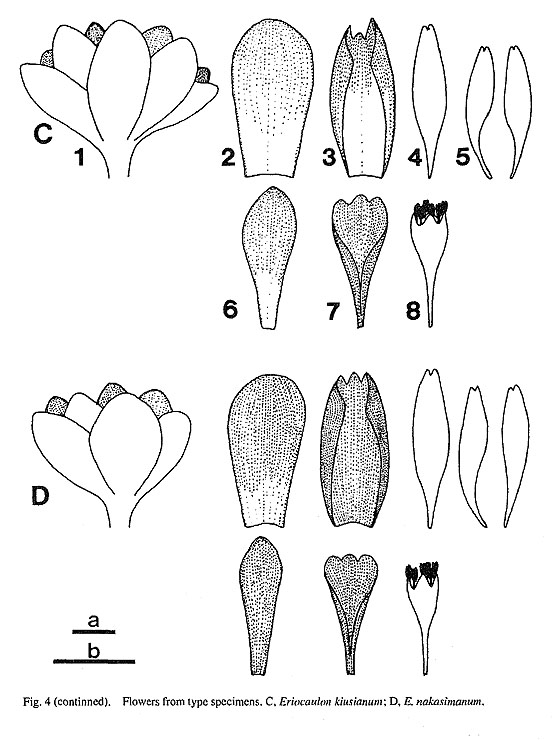 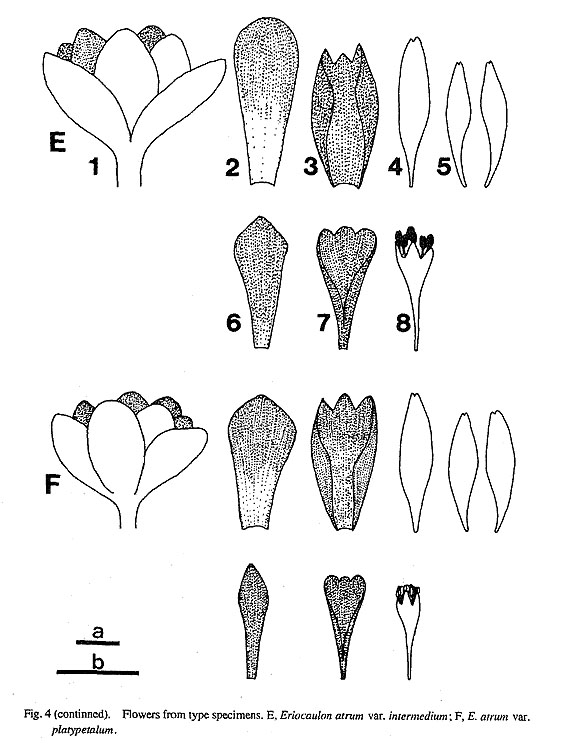
|
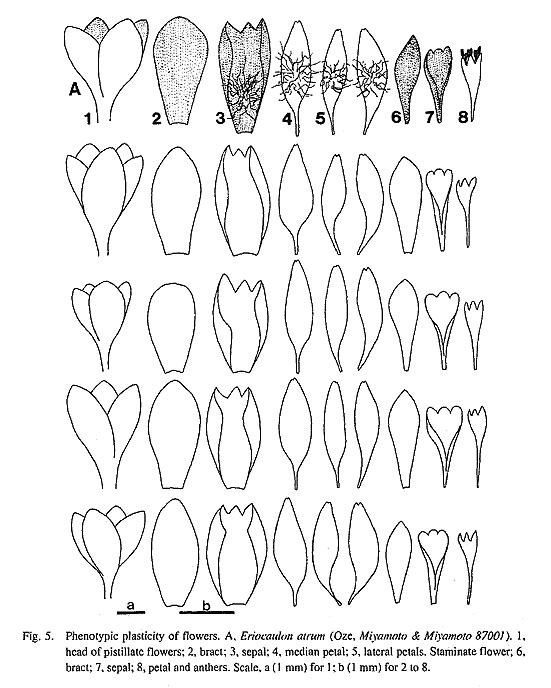 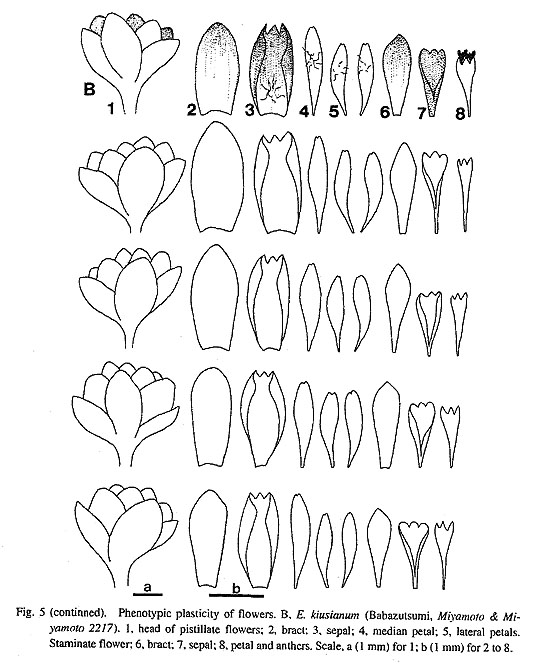 
|
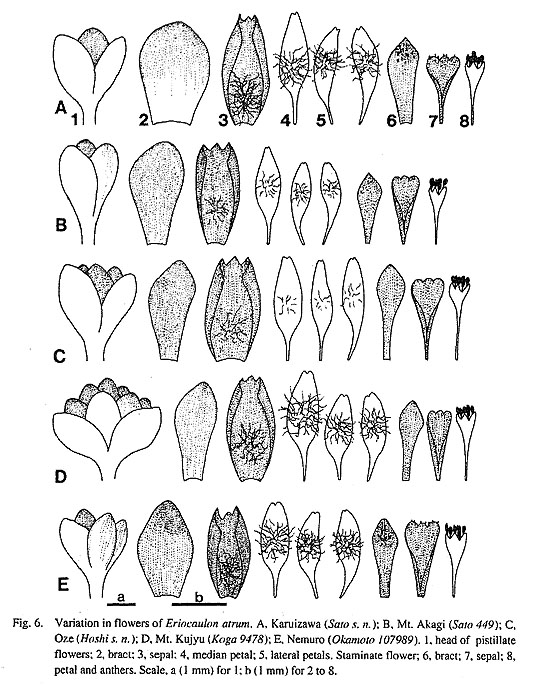

Discussion
Because of overlap within characters previously thought to be diagnostic, we are able to recognize only two species, E. atrum Nakai and E. kiusianum Maxim., clearly separated by some morphological characters of the flowers, among the material we studied. Eriocaulon atrum is characterized by clawed central petals 0.4-0.7 mm wide in the female flowers. Eriocaulon kiusianum has sessile flowers 0.2-0.4 mm wide in the female flowers.
Eriocaulon nakasimanum Satake, which was distinguished from E. atrum by the female flowers having glabrous petals and sepals, is placed in synonymy under E. kiusianum.
Eriocaulon nasuense Satake, distinguished from E. kiusianum by the hairiness of the flowers, also falls in synonymy under E. kiusianum. Eriocaulon atrum var. intermedium Nakai ex Satake and E. atrum var. platypetalum Satake are also regarded as synonyms of E. kiusianum.
Eriocaulon glaberrimum Satake. which was characterized by the pistillate flowers having glabrous sepals. and E. hananoegoense Masam., distinguished by the staminate flowers having glandular hairy bracts, are indistinguishable from typical E. atrum.
Hooker (1894) cited two specimens, Sikkim, J. D. Hooker s. n. (K) and Khasia, J. D. Hooker & C. B, Clarke s. n. (K). under the name Eriocaulon alpestre. These specimens were, in fact, misidentified and are E. atrum.
Eriocaulon atrum is distributed from Nepal, Bhutan and northern India across southwestern China to Korea and from Yakushima to eastern Hokkaido (Nemuro Peninsula) in Japan (Figs. 9 and 10). Eriocaulon kiusianum is distributed in Japan from Yakushima to Tochigi Prefecture in central Honshu (Figs. 9 and 10). From its distribution, E. atrum is considered to be a Sino-Japanese element. This is the first finding of a Sino-Japanese floristic element among aquatic plants. The distribution pattern of E. atrum is similar to that of Tiarella polyphylla D. Don and Swertia bimaculata (Siebold & Zucc.) Hook. f. & Thomson (Kanai 1963). It is noteworthy that these species occur at high elevations in southern Japan. The detailed distribution in China and Korea is unclear, because we have examined only two specimens from China (Tibet and Yunnan) and one from Korea (Hamgyong North).



Taxonomic treatment
Eriocaulon atrum Nakai in Repert. Spec. Nov. Regni Veg. 9:466 (1911). Holotype. Japan. Tochigi Prefecture, Akanumahara, Nikko, S. Kodama s. n. (TI). [Figures 4 A; B; 5 A, C; 6; 9; 10 & 11]
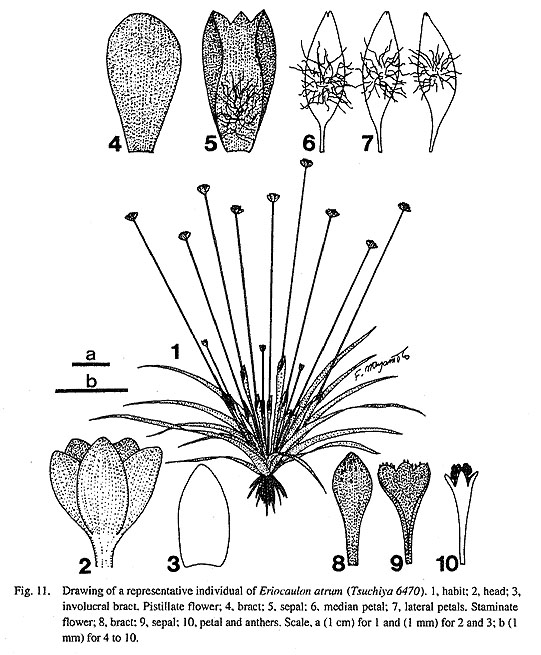
E. glaberrimum Miyabe ex Satake in Acta Phytotax. Geobot. 13: 280 (1943). Holotype. Japan. Nemuro Shicho, Ochiishi, Nemuro city, M. Tatewaki 2974 (TNS).
E. atrum Nakai var. glaberrimum (Satake) T. Koyama in Ohwi, Fl. Jap., Engl. ed.: 270 (1965).
E. hananoegoense Masam. in Mem. Fac. Sci. Taihoku Imp. Univ. 11: 537 (1934). Lectotype. Japan. Kagoshima Prefecture, Yakushima, Hananoego, Masamune s. n. (TI).
E. atrum Nakai var. hananoegoense (Masam,) T, Koyama in Ohwi, Fl. Jap. Engl. ed.: 270 (1965).
Distribution. Japan (Hokkaido, Honshu, Kyushu), Korea, China, India, Bhutan, and Nepal.
SPECIMENS EXAMINED. Japan. Hokkaido: Nemuro, Onnenai, Nemuro city, 10 m, F. Miyamoto & K.
Miyamoto 89052-56 (TI); Bettoga, 60 m, Nemuro city, F. Miyamoto et K. Miyamoto 89042-47 (TI); Ochiishi, Nemuro city, Okamoto 107989 (TNS); Ochiishi, Nemuro city, 50 m, F. Miyamoto & K. Miyamoto 89048-51, 921022-25 (TI). Honshu. Aomori: Shiriya, Higashidori-mura, Shimokita-gun, Mori 18299 (MAK); Kizukuri machi, Nishi-tsugaru-gun, M. Furuse s. n. (KYO). Fukushima: Aizu, Osakafu-jyoshi-senmongakko 99963 (MAK); Aioda, Tamura-gun, Y. Hattori 2 (TI); Komadome-moor, Showa-mura, Minami-aizu-gun, 1000 m, M. Tsuchiya 6470, 6471 (TI); Kanayama, Omotego-mura, Nishi-shirakawa-gun, Y. Furuse 41477 (KYO); Oze, D. Hoshi s. n. (KYO); Ozegahara, H. Hara s. n. (TI); Lake Oze, S. Shimazu s. n. (TI); Numajiri, Oze, Y. Satake 151674 (TNS). Tochigi: Mt. Nasu, Nasu-cho, Suwki 43161 (TNS); Mt. Nasu, Nasu-cho, Mori 253873 (TNS); Shimizudaira-shitsugen, Sanbonyari, H. Kanto 7 (TI); Shimizudaira, north of Mt. Asahi, Nasu, 1800 m, G. Murata 18295 (KYO); Numappara, Nasu, S. Kitamura s. n. (KYO); Nuroappara, Nasu, Kawamura 271718 (TNS); Num appara, Nasu, Kuramoto 439145 (TNS); Numappara, Nasu, 1250 m, T. Yoshizawa 29673, 29672, 29674, 29675 (TI); Akanumahara, Nikko, Tsurumachi 101017 (MAK); Akanumahara, Nikko. T. Makino 107999 (MAK); Nikko, T. Makino 232845 (MAK); Nikko, Uchiyama 2413 (TNS); Utsunomiya city, Kanto 101018 (MAK). Gunma: Baragi, Manza, Tsumagoi-mura, Azuma-gun, K. Matsuda 385792 (TNS); Tsumagoi-mura, Azuma-gun, K. Matsuda 376570 (TNS); Baragi, Hoshimata, Tsumagoi-mura, Azuma-gun, K. Matsuda s. n. (KYO); Mt. Akagi, Honda 101016 (MAK); Mt, Akagi, T. Sato 449 (TI). Kanagawa: Hakone-osawa, Hakone-cho, Ashigarashimo-gun, T. Makino 108001 (MAK). Nagano: Kidoike, Shigakogen, Takei 99199 (TNS); Shigakogen, Shimo-takai-gun, Fujisawa 7368 (MAK); Karuizawa, K. Sato s. n. (TI, TNS); Yagasaki, Karuizawa-cho, K. Sato 308616 (TNS); Matori, Karuizawa-cho, M. Tsuchiya 2653 (TI); Minami-karuizawa, Karuizawa-cho, Kitasaku-gun, K. Sato s. n. (TNS); Minami-karuizawa, Karuizawa-cho, Kitasaku-gun, M. Furuse 39400 (KYO); Minami-karuizawa, Karuizawa-cho, Kitasaku-gun, Matsuda s. n. (TI); Oita: Mi-ike, Mt. Kujyu, Kujyu-cho, Naoiri-gun, 1690 m, Koga 9478 (TI). Kagoshima: Mt. Nagata, Yakushima, Z. Tashiro s. n. (KYO); Shikanosawa, ML Na-gata, Yalaishima, Y. Furuse 41706. 41707, 41710 (KYO); Mt. Miyanoura, Yakushima, T. Makino 101051,108141 (MAK); en route from Kuromi woodland path to Hananoego swamp, Yakushima, G. Mu-rata et al. 290 (KYO); en route from Hananoego to Minami zawa Gorge via Ishizuka-goya Hut, Yakushima, K. Iwalsuki et al. 56 (KYO); Yakushima, Hananoego. M. Tagawa 1993 (KYO, TNS). Korea. Hamgyong North (Kanhoku), R. Saito 1780 (KYO). China. Tibet [Xizang], Chumbi, G. King 46 (K);Yunnan, J. M. Delavay 3244 (K). Bhutan. Wangdi Phodrang, Nika chhu-Bhja, 2620 m, F. Miyamoto 9361516, 9361518 (TI). India. Sikkim, 8000-12000 ft., J. D. Hookers. n. (K); Sikkim, G. King s. n. (K); Khasia, 5000-6000 ft., J. D. Hooker & T. Thomson s. n. (K); Khasia, Myrung, 5000 ft., C. B. Clarke 4485 (K), Nepal. Seti Zone, Bajhang and Bajura Distr., Khaptad National Park, 3000 m, M, Suzki et al. 9170995, 9170976, 9170977 (TI).
Eriocaulon kiusianum Maxim. in Bull. Acad. Sci. St.Petersb. 8: 22 (1892). Holotype. Japan. Nagasaki [Prefecture]: in pricipatu Simabara, C. J. Maximowicz s. n. (LE; isotypes: BM, K). [Figures 4 C, D, E, F; 5 B; 7; 9; 10 & 12]
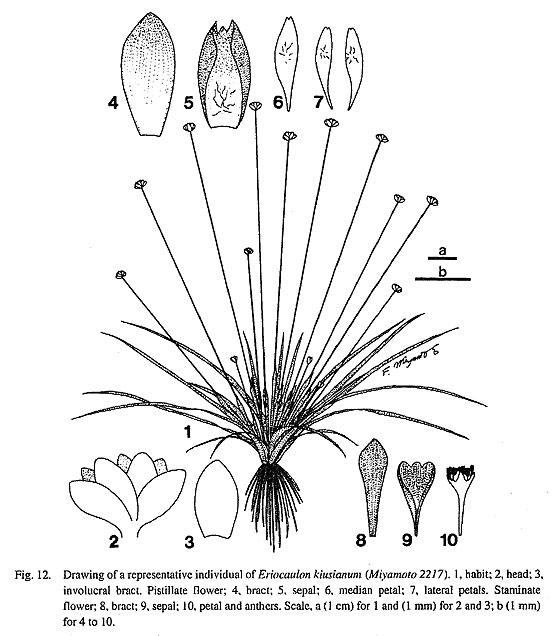
E. nakasiinanum Satake in J. Jap. Bot. 15: 143 (1939). Holotype, Japan. Fukuoka Prefecture, Yakatabaru, Fukuoka city, K. Nakajima 49 (TI).
E. atrum Nakai var. nakasimanum (Satake) T. Koyama in Ohwi, Fl. Jap. Engl. ed.: 270 (1965).
E. nasuense Satake in J. Jap. Bot. 46: 110, fig. 1-2 (1971). Holotype. Japan. Tochigi Prefecture, Minami-kanemaru, Otawara city, B. Kawamura 271724 (TNS).
E. atrum Nakai var. intermedium Nakai ex Satake in J. Jap. Bot. 15: 142 (1939). Holotype. Japan. Okayama Prefecture, Keyaki, Showa-cho, Kibi-gun, Z Yoshino 30 (TI; isotype: MAK).
E. atrum Nakai var. platypetalum Satake in J. Jap, Bot. 15: 632 (1939). Holotype. Korea. Cheju-do, E. Taquets.n. (TI).
Distribution. Japan (Honshu, Kyushu) and Korea.
SPECIMENS EXAMINED. Japan. Honshu. Ibaraki: Mito city, T. Makino 101015 (MAK). Tochigi: Konuma, Shiobara-cho, Shioya-gun, 970 m, F. Miyamoto 89111, 891112 (TI); Minami-kanemaru, Otawara city, S. Kitamura s. n. (KYO); Minami-kanemaru, Otawara city, S. Kitamura s. n. (KYO). Chiba: Mobara city, T. Makino 108000, 165804 (MAK). Niigata: Chokushi-ike, Ikeda-mura. R. Kofuji 66206 (TNS). Shi-zuoka: Jukkoku pass, Hakone, T. Takeuchi 111053 (TNS); Haccho-ike, Mt. Amagi, H. Shimizu 465 (MAK, TI); Haccho-ike, Mt. Amagi, Hashimoto 44199 (TNS); Haccho-ike, Mt. Amagi, K. Hisauchi 760 (TI). Aichi: Mamushi-ike, Aichi-gun, C. Funahashi s. n. (TI); Nabeya-ueno, Nagoya city, J. Ohwi s. n. (KYO); Makino-ike, Chigusa-ku, Nagoya city, T. Makino 108009 (MAK); Ueno-sanroku, Nagoya city, Umemura 108004 (MAK); Nagoya city, Umemura 108003 (MAK); Toyohashi city, T. Makino 108006, 108007 (MAK); Futamatagawa, Toyohashi city, T. Makino 108005 (MAK). Shiga: Tachiki-yama, Ohtsu city, C. Hashimoto 10543 (KYO); Ohtsu city, 85 m, G. Murata 70587 (KYO); Yasu-cho, Yasu-gun, G. Murata 115593 (MAK). Kyoto: Tachi-cho to Iden, Ayabe city, 100 m, G. Murata et al. 34014, 425557 (KYO, MAK, TNS); Oobatake-Iden, Ayabe city, 50-100 m, (KYO). Osaka: Kumatori-cho, Sennan-gun, unknown collector (KYO); Toyonaka city, Z. Yoshino s. n. (TI); Toyonaka city, N. Ui 21 (TI). Hyogo: Ono-cho, Kato-gun, unknown collector 21 (TI); Natsumi-ike, Nakanishi-cho, Kasai city, N. Kurosaki 15403 (KYO); O-ike, Nishiwaki city, N. Kurosaki & Y. Takita 254 (KYO); Uneo-ike, Yokayama, Nishiune, Ako city, 100 m, N. Kurosaki & T. Kato 47 (KYO); Aonogahara, Ono city, S. Hosomi 10636 (KYO); Imada, Imada-cho, Taki-gun, S. Hosomi 5949 (KYO); Kuroishi, Imada-cho, Taki-gun, S. Hosomi s. n. (KYO); Ono-cho, K. Matsuda s. n. (TNS); Arima, Kobe city, T. Makmo 101019 (MAK); Shiratoridai, Himeji city, 50 m, N. Kurosaki 564741 (TNS). Nara: unknown locality, K. Morimoto s. n. (KYO); Minoo-ike, Kitakatsuragi-gun, Z Yoshino s, n (TI). Wakayama: Nagaidani, Shinjo-mura, Nishimuro-gun, T. Nakajima s. n. (TI). Okayama: Inago-rnura, G. Moriya s. n. (KYO); Keyaki, Showa-cho, Kibi-gu, T. Nakajima s. n. (TI); lyama, Kibi-gun, Z Yoshino s. n. (KYO, TI, TNS); Takamaru-ike, Tomiyama-mura, Z Yoshino s. n. (TI); Taka-matsu, Kibi-gun, Z. Yoshino s. n. (TI). Hiroshima: Kunichika, Kurose-cho, 220 m, M. Shimoda 20 (TI); Ryugami-ike, Nagano, Saijyo-cho, Hiroshima city, 380 m, M. Shimoda 17 (TI); Kami-ike, Morichika, Saijyo-cho, Hiroshima city, 240 m, M. Shimoda 18 (TI); Otake, Hachihonmatsu-cho, Hiroshima city, 240 m, M. Shimoda 16 (TI); Naga-ike, Akasaka, Fukuyama city, Takafuji 286062 (TNS). Yamaguchi: Nagasawa-ike, Chusenji, Yamaguchi city, H. Mazaki 290104 (TNS); Nishikawachi-ike, Onoda city, H. Mazaki 30271 (KYO, TNS); Sugawa, Yamaguchi city, K. Oka 34467 (TNS); Sugawa, Yamaguchi city, K. Oka 34466 (TI). Kagawa: Kawada-ike,Ochi-cho, Okawa-gun, S. Mitani 6 (TI); Ichinose, Minamikawa, Okawa-cho, 1106 (TI); Takadada, Shirotori-cho, unknown collector 1094 (TI); Shiota-oku, Densyonishi, Manno-cho, Nakatado-gun, unknown collector 1104 (TI). Ehime: Tano, Syusou-gun, 1. Kingo 6 (KYO). Fukuoka: Yoshida, Kokura-minami-ku, Kita-kyushu city, S. Masumura 3112 (TI); Hanahirakami-ike, Yamanaka, Kuroki-cho. Yame-gun, 500 m, unknown collector 7102 (KYO); Sumiyoshi-ike, Gosyogadani. Tuzumi, Yukuhashi city, 40 m, 5. Masumura 3114, 11033 (TI); Amoda, Ikuhashi city, 30 m, F. Miyamoto & K. Mivamoto 2217-22, 2225 (TI): Babazutsumi, Honami-cho, Kaho-gun, 60 m, F. Miyamoto &. K. Miyamoto 2203-13 (TI); Yakatabaru, Fukuoka city. unknown collector 49 (Tl); Yasu-mura, Asakura-gun, unknown collector 17403 (TI); Yamanaka, Kuroki-cho, Yame-gun, unknown collector 9457 (TI); Yakaiabaru, Fukuoka city, K. Nakajima 60 (TI); Kasuga-mura, Shikushi-gun, K. Nakajima 61 (TI); Nakahirokawa-mura, Yame-gun. K. Nakajima 62 (TI); Yamagami-ike, Hirahara, Kawauchi, Buzen city, 110 m, N. Inokami 11113 (TI); Fuchihaku-ike, Hirabaru, Buzen city, 5. Masumura 3109 (TI); Ogochi, Ohira-mura, Chikujyo-gun, 210 m, Koga 9482 (TI); Otogane, Ohnojyo city, 65 m, Koga 8407 (TI); Ko-radai, Kamitsu-cho, Kurume city, 40 m, N. Inokami 10844 (TI); Koradai, Kamitsu-cho, Kurume city, 50 m, F. Miyamoto & K. Miyamoto 2181-87 (Tl); Kaminoji, Shimokarahara, Ohira-mura, Chikugami-gun, 40 m, N. Inokami 10906 (TI); Yamanaka, Kuroki-cho, Yame-gun, 440 m, N. Inokami 10980 (TI); Shiroshima, T. Sugino s. n. (KYO); Abura-yama, Fukuoka city, Hirono 304922 (TNS); Shimo-hirokawa-mura, Yame-gun, K. Nakajima 304921 (TNS); Tsuchisada-ike, Z. Tashiro s. n. (KYO); Imafuku, Yame city, S. Masumura 4578 (TI). Saga: Akasaka, Hizen-cho. Kuranarl s. n. (KYO); Chinzei, Tuchimine-mura, Kuranarl 216719 (TNS): Mizuo, Yamauchi-cho, Kishima-gun, 110 m, Koga 8401 (TI); Onohara, Ureshino-cho, Fujitu-gun, Baba 216725 (TNS). Nagasaki: Maisubara, unknown collector (TI); Suwa-no-ike, F. C. Greatrex N.44/39 (TI); Omura-cho, Z. Tashiro 29999 (TNS). Kumamoto: Syoya-ike. Fukada-mura, 200 m, F. Miyamoto & K. Miyamoto 2161 (TI). Oita: Osada-ike, Osada, Nakatsu city, T. Makino 108008 (MAK); Lake Odako, West of Yunohira, T. Koyama 1017 (TI); Yabakei, Y. Oto s. n. (KYO); Hinokibaru, Yabakei-cho, Shimoge-gun, 540 m, Koga 7599 (TI). Miyazaki: Mt. Koshiki, H. Kitano 51 (KYO); Hyuga city, Mimitsu Station, Hatusima et al. 22712 (KYO, MAK); Hyuga city, Mimitsu Station, 3 m, T. Minamitani 5762 (KYO); Kawaminami-mura, M. Nagasawa s. n. (KYO, TNS); Ehara, Higashi-kami-naka, Sadowara-cho, Miyazaki-gun, S. Masumura 6502 (TI); Mt. Koshiki, Ebino city, 1300 m, T. Minamitani 7048 (KYO); Mt. Koshiki, Ebino city, 1200-1300 m, Murata et al. 75 bis (KYO); Kirishima, Ebino city, S. Sako s. n. (MAK, TI); Mt. Kirishima, Ebino city, Z Tashiro s. n. (KYO); Byakushi-ike, Ebino-kogen. Ebino city, 1280 m, F. Miyamoto & K. Miyamoto 2001 (TI). Kagoshima: Kamiike, Sendai city, Hatusima & Sako 27304 (KYO); Sendai-cho, y. Doi 50 (KYO); Togo-mura, Y. Doi 58 (KYO); Kachime-mura, Y. Doi 60 (KYO); Tanegashima, Z, Tashiro s. n. (KYO); Fumoto, Sendai city, 10 m, Hatusima & Sako 51751 (MAK); Yakushima, G. Koidzumi s. n. (KYO); Shikonosawa, Mt. Nagata, Yakushima, y. Furuse 41711 (KYO); Hananoegoh, Yakushima, S. Mitsuta and D. E. Boufford 72, 79 (KYO).
References
- Hooker, J. D. 1894.
- Eriocaulaceae. In J. D. Hooker (ed.). Flora of British India 5. pp. 571-585. L. Reeve & Co., Ltd.. Kent.
- Kanai, H. 1963.
- Phytogeographical observations on the Japano-Himalayan elements. J. Fac. Sci. Univ. Tokyo, Sect. 3, Bot. 8: 306-339.
- Ruhland, W. 1903,
- Eriocaulaceae. In A. Engler, Das Pflanzenreich. Heft 13.1m Auftrage der Preuss. Berlin.
- Satake, Y. 1940.
- Eriocaulaceae. In T. Nakai and M. Honda, Nova Flora Japonica. Vol. 6. Sanseido, Tokyo.
- Satake. Y, 1971.
- Two new plants from Nasu District. J. Jap. Bol. 46: 109-111 (in Japanese).
- Satake, Y. 1983.
- Eriocaulaceae. In Y. Satake. J. Ohwi, S. Kitamura, S. Watari and T. Tominari (eds.). Wild Flowers Japan. Herbaceous Plants 1, pp. 75-84. Heibonsha, Tokyo (in Japanese).
